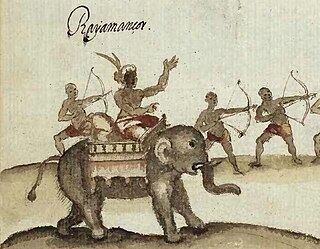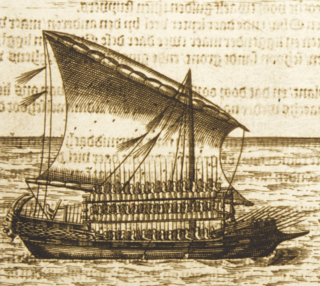Nur al-Din is a male Arabic given name, translating to "light of Faith", nūr meaning "light" and dīn meaning "religion". More recently, the name has also been used as a surname.

Jawi is a writing system used for writing several languages of Southeast Asia, such as Acehnese, Magindanawn, Malay, Mëranaw, Minangkabau, Tausūg, and Ternate. Jawi is based on the Arabic script, consisting of all 31 original Arabic letters, six letters constructed to fit phonemes native to Malay, and one additional phoneme used in foreign loanwords, but not found in Classical Arabic, which are ca, nga, pa, ga, va, and nya.
Hamzah Fansuri was a 16th-century Sumatran Sufi writer, and the first writer known to write mystical panentheistic ideas in the Malay language. He wrote poetry as well as prose. He has been called the "first Malay poet" and the first known poet to have written in the Malay poetic form syair.

Syed Muhammad al Naquib bin Ali al-Attas is a Malaysian Muslim philosopher. He is one of the few contemporary scholars who is thoroughly rooted in the traditional Islamic sciences and studied theology, philosophy, metaphysics, history, and literature. He pioneered the concept of Islamisation of knowledge. Al-Attas' philosophy and methodology of education have one goal: Islamisation of the mind, body and soul and its effects on the personal and collective life of Muslims as well as others, including the spiritual and physical non-human environment. He is the second Malaysian to be awarded the title of Royal Professor after the late Ungku Abdul Aziz.

The Sultanate of Aceh, officially the Kingdom of Aceh Darussalam, was a sultanate centered in the modern-day Indonesian province of Aceh. It was a major regional power in the 16th and 17th centuries, before experiencing a long period of decline. Its capital was Kutaraja, the present-day Banda Aceh.

Iskandar Muda was the twelfth Sultan of Acèh Darussalam, under whom the sultanate achieved its greatest territorial extent, holding sway as the strongest power and wealthiest state in the western Indonesian archipelago and the Strait of Malacca.
Iskandar Thani Alauddin Mughayat Syah was the thirteenth sultan of Aceh, following the powerful Iskandar Muda. Iskandar Thani was the son of the 11th sultan of Pahang, Ahmad Shah II, who was brought to Aceh in the conquest of Pahang in 1617 by Iskandar Muda. He married the sultan's daughter, the later Sulṭāna Taj ul-Alam, and succeeded Iskandar Muda as sultan when he died in 1636.

Sulṭāna Taj ul-Alam Safiatuddin Syah was the fourteenth ruler of Aceh. She was the daughter of the sultan Iskandar Muda and the wife of his successor, Iskandar Thani. She became sulṭāna upon the death of her husband and ruled from 1641 to 1675, being the first of four women to hold the position in succession.

Malay Indonesians are ethnic Malays living throughout Indonesia. They are one of the indigenous peoples of the country. Indonesian, the national language of Indonesia, is a standardized form of Riau Malay. There were numerous kingdoms associated with the Indonesian Malays along with other ethnicities in what is now Indonesia, mainly on the islands of Borneo and Sumatra. These included Srivijaya, the Melayu Kingdom, Dharmasraya, the Sultanate of Deli, the Sultanate of Siak Sri Indrapura, the Riau-Lingga Sultanate, the Sultanate of Bulungan, Pontianak Sultanate, and the Sultanate of Sambas. The 2010 census states that there are 8 million Malays in Indonesia; this number comes from the classification of Malays in East Sumatra and the coast of Kalimantan which is recognized by the Indonesian government. This classification is different from the Malaysia and Singapore census which includes all ethnic Muslims from the Indonesian archipelago as Malays.

Acehnese or Achinese is an Austronesian language natively spoken by the Acehnese people in Aceh, Sumatra, Indonesia. This language is also spoken by Acehnese descendants in some parts of Malaysia like Yan, in Kedah. Acehnese is used as the co-official language in the province of Aceh, alongside Indonesian.

The Acehnese, also written as Atjehnese and Achinese, are an indigenous ethnic group native to Aceh, Indonesia on the northernmost tip of the island of Sumatra. The area has a history of political struggle against the Dutch colonial rule. The vast majority of Acehnese people are Muslims. The Acehnese people are also referred to by other names such as Lam Muri, Lambri, Akhir, Achin, Asji, A-tse and Atse. Their language, Acehnese, belongs to the Aceh–Chamic group of Malayo-Polynesian of the Austronesian language family.

Gunongan Historical Park is located in the Aceh Province of Sumatra, Indonesia. Possibly built by Iskandar Muda, the grounds of the historical park contain a 17th-century palace, garden, and white circular structure whose purpose is unknown, the Gunongan, after which the park has been named. The origins and function of the Gunongan palace are obscure, though it is theorized to be either built on the remains of an older structure or built during the 17th century, combining Hindu and Islamic aesthetics. Its function possibly had a sacred significance but it later became a leisure ground for the Acehnese royal family.
Sayyid ʿAbdullāh bin Shaykh al-ʿAydarūs was a Hadhrami religious leader who lived in the 16th century and a descendant of Abu Bakr al-ʿAydarūs, a prominent saint who started the al-ʿAydarūs branch of the Bā ʿAlawiyyah clan.

Barus is a town and kecamatan (district) in Central Tapanuli Regency, North Sumatra Province, Sumatra, Indonesia. Historically, Barus was well known as a port town or kingdom on the western coast of Sumatra where it was a regional trade center from around the 7th or earlier until the 17th century. It was also known by other names, namely Fansur and possibly Barusai. The name Fansur or Pansur means "spring of water" or "a place where water flows" in the local Malay language/Batak language. Barus was well known for its production of camphor. In the 16th century, Barus became absorbed into the rising power of the Aceh Sultanate. The earliest known Malay poet Hamzah Fansuri may be from Barus as indicated by his name.

Sultan Alauddin Mansur Syah was the eighth Sultan of Aceh in northern Sumatra. He ruled Aceh from 1579 to 1585 or 1586 and was known as a pious Muslim ruler with cultural interests. His reign also saw some military expansion on the Malay Peninsula. With his death ended a 65-year long period of warfare between Aceh and the Portuguese.

Classical Malay literature, also known as traditional Malay literature, refers to the Malay-language literature from the Malay world, consisting of areas now part of Brunei, Singapore, Malaysia, and Indonesia; works from countries such as the Philippines and Sri Lanka have also been included. It shows considerable influences from Indian literature as well as Arabic and Islamic literature. The term denotes a variety of works, including the hikayat, poetry, history, and legal works.

Abd al-Rauf ibn Ali al-Fansuri al-Sinkili was a renowned Islamic scholar, spiritual leader of the Shattariyya tariqa and mufti of the Aceh Sultanate. He was a confidant of Sultana Safiat al-Din and first to spread the Shattari Sufi order in Indonesia and Southeast Asia. Many of his students became disseminators of Islam. He is commonly known as Sheikh Abd al-Rauf al-Sinkili and posthumously as Teungku Syiah Kuala.

Ghali, gali, or gale are a type of galley-like ships from the Nusantara archipelago. This type of ship only appeared after the 1530s. Before the appearance of this type of ship, several native galley-like ships already existed in the archipelago, some with outriggers. The design of ghali is the result of the impact made by Mediterranean shipbuilding techniques on native shipbuilding, introduced particularly by Arabs, Persians, Ottoman Turks, and Portuguese. The terms may also refer to Mediterranean vessels built by local people, or native vessels with Mediterranean influence.














